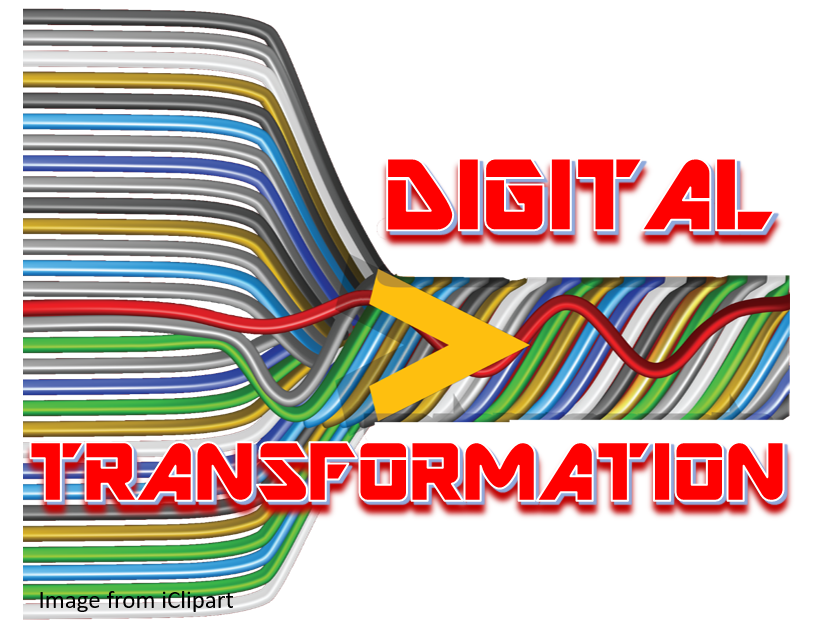Change and change management have roiled organizations throughout history. Centuries ago Niccolo Machiavelli, in his classic The Prince, wrote, “There is nothing more difficult to take in hand, more perilous to conduct, or more uncertain in its success, than to take the lead in the introduction of a new order of things, because the innovator has for enemies all those who have done well under the old conditions, and lukewarm defenders in those who may do well under the new.” In the digital age, the new order of things requires companies to transform into digital enterprises. Transformation is tougher than even Machiavelli imagined because it goes beyond mere change. “Digital transformation,” explains Michelle Chan (@chanweiyan), “is a lot more than just adopting new tech — each company will take a different approach.”[1] Even though each digital transformation experience is unique, Chan reports, “The Information Services Group (ISG) has identified five digital transformation ‘archetypes’. These represent various approaches to digital transformation, addressing different challenges.” Those archetypes are: legacy transformers; strategic transformers; cloud-first transformers; digital enterprise natives; and disruption embracers.
Understanding digital transformation
Today business leaders are being told they need to “innovate or die” and, at the same time, they are being told they need to “transform or become obsolete”. There can be little doubt such warnings are the result of living in rapidly changing world. Daniel Newman (@danielnewmanUV), CEO of Broadsuite Media Group, writes, “Innovation and transformation are often used synonymously, but they are different in the digital world. In some instances, transformation can lead to innovation. In others, innovation can lead to transformation, but this mutually causal relationship is often overlooked since they are thought to mean the same thing. While indeed related, it is crucial for modern business leaders to know the difference between the two terms.”[2] He goes on to note, “Digital transformation describes the process by which a company forms a strategy to implement technology to improve business and meet the ever changing demands of the consumer. The goals of a digital transformation can include broadening the company’s reach, improving operational efficiency, transmuting the company’s culture and image, or all the above.” As Chan noted, digital transformation involves more than implementing technology, and, as Newman noted, it involves transmuting culture and image as well. To highlight how different digital transformation journeys can be, let’s look a little closer at the ISG archetypes as summarized by Chan.
Legacy Transformers. Chan writes, “The name is self-explanatory as legacy transformers are heavy on setting up legacy IT systems. Usually, these companies face technology and organizational silos previously built in, but face pressure to transform due to situations such as mergers, actions of their competition, or adopting new tech.” In many ways, legacy transformers will have the most difficult time transforming. Business analyst and author Joe McKendrick (@joemckendrick) explains, “We’re making some progress toward achieving highly digitized enterprises, but it’s going to take time. The problem is technology solutions are being dropped on top of — or are being used to pave over — outdated, calcified processes.”[3] Chan adds, “A change of mindset is a fundamental part of this group’s digital transformation success.”
Strategic Transformers. According to Chan, “This group isn’t blindly walking into digital transformation. They have planned a roadmap and are moving in phases with strong consideration to the partners and solutions they onboard. Strategic transformers will be seasoned in outsourcing and will be well on their way to shifting their business operations to the cloud.” According to Keshav Murgesh, group CEO of WNS Global Services, developing a successful strategy can prove challenging. He explains, “Formulating a strong digital transformation strategy that allows a company to transform its business, implement the right technologies and build the right talent is a herculean task. … A true digital enterprise takes a strategic and not a piecemeal approach to digitalization. It cannot be about implementing digital technologies as an extension of an existing process without transforming the process end-to-end.”[4]
Cloud-first Transformers. Chan writes, “With cloud already an ingrained part of their business, cloud-first transformers see digital transformation as a further extension. With small and agile IT departments, they see technology as a driver of change and growth within the organization. That said, IT considered to be ‘disruptive’ may be used only after rigorous testing.” McKendrick cites Phil Wainewright, co-founder of Diginomica, who is a proponent of what he calls a frictionless enterprise. Wainewright asserts, “A frictionless enterprise is on-demand: Cloud computing has paved the way for an on-demand economy, with an abundance of resources available to enterprises with a keystroke. ‘You can use resources as you need them, as they’re made available. It’s very much an as-a-service model.'” Other traits of the frictionless, cloud-based enterprise include: ubiquity (a decision-maker has everything he needs to make a decision regardless of his location); real-time processes (information is available as events happen); collaboration (great connectivity); agile (ready to make changes); and customer-centric.
Digital Enterprise Natives. Obviously, digital enterprise natives don’t need to transform into digital enterprises. They are often viewed as examples needing to be followed by enterprises needing to transform. Chan writes, “New technologies sit at the heart of these companies’ customer-centric culture and competitive strategy. IT is considered a revenue generator, rather than a department to be tentatively budgeted. Digital enterprise natives are set on boosting revenue, being more flexible for their customers and getting ahead of competitors.” Every digital enterprise native embraces artificial intelligence (AI) as a must-have technology.
Disruption Embracers. According to Chan, “These businesses, with advanced but stable IT operations, are those that are open to the disruptive potential of new IT solutions. Experimental by nature, new methods and technology will be embraced and put to the test, but quickly rejected if pilots or proofs-of-concept turn back poor results. Disruption embracers should strive to enable their entire business to be agile, not just the IT department. New methods, solutions, and organization can contribute to this.” Disruption embracers understand how innovation helps transformation efforts. Newman explains, “Innovation is the rethinking or reimagining of a business process that already exists. Essentially, once a transformation is realized and the new reality is established, innovation describes when those norms are again challenged.”
Concluding thoughts
Murgesh concludes, “Without the right strategy and the right culture, adoption of digital technologies will stay half-baked, and hence either be of limited value or a complete waste of effort. An organization’s move towards digitalization must be rooted in a digital transformation strategy that allows it to re-imagine its business and be better prepared for change.” Paul Daugherty (@pauldaugh), chief technology and innovation officer at Accenture, and H. James Wilson (@hjameswilson), managing director of information technology and business research at Accenture Research, see today’s digital transformation efforts as the third wave of business transformation. They explain, “The first wave of business transformation involved standardized processes. This era was ushered in by Henry Ford, who deconstructed the manufacture of automobiles so that they could be made on an assembly line. … The second wave consisted of automated processes. This era emerged in the 1970s and peaked in the 1990s with the business process reengineering (BPR) movement, thanks to advances in information technology (IT): desktop computers, large databases, and software that automated various back-office tasks. … Now, the third wave involves adaptive processes. This third era, which builds on the previous two, will be more dramatic than the earlier revolutions enabled by assembly lines and digital computers, and will usher in entirely new, innovative ways of doing business. … This adaptive capability is being driven by real-time data rather than by an a priori sequence of steps. The paradox is that although these processes are not standardized or routine, they can repeatedly deliver better outcomes. In fact, leading organizations have been able to bring to market individualized products and services (as opposed to the mass-produced goods of the past), as well as deliver profitable outcomes.”[5] They insist this third wave is being driven by artificial intelligence and note, “The third wave has created a huge, dynamic, and diverse space in which humans and machines collaborate to attain orders-of-magnitude increases in business performance.” Regardless of the unique path your transformation journey follows, you need to take cognitive technologies along for the ride.
Footnotes
[1] Michelle Chan, “The five types of digital transformation,” Hybrid News, 29 April 2019.
[2] Daniel Newman, “Innovation Vs. Transformation: The Difference In A Digital World,” Forbes, 16 February 2017.
[3] Joe McKendrick, “6 traits all successful digital enterprises have in common,” ZDNet, 2 September 2017.
[4] Keshav Murgesh, “No shortcuts in digital transformation,” Live Mint, 8 September 2017.
[5] Paul Daugherty and H. James Wilson, “How artificial intelligence is driving digital transformation,” Information Management, 23 March 2018.





